This is our first text, so safety comes first:
Candle manufacturers make every effort to ensure that candles are as safe as possible. However, they still burn with an open flame! Therefore, always follow basic rules to safely enjoy them and avoid fires, burns, or unwanted effects.
The most important rules are:
• Never leave a burning candle unattended!
This way you can react immediately if the candle starts behaving strangely or tips over because it wasn’t properly secured. Always extinguish a burning candle before leaving the room, even if just for a “moment.”
• A burning candle should be kept away from flammable items!
Flammable objects, decorations, curtains, or paper should be kept far away from the candle. The distance depends on the type of candle and the size of its flame. Remember that the flame can increase in size during burning.
• Burning candles should not be near children and pets!
Children may be drawn to burning candles and may want to touch the flame or play with the candles. Cats are known for their curiosity, and dogs may accidentally knock over a candle if they brush against a table where a candle is burning. They usually do this with their tails.
• Immediately extinguish a candle that emits soot!
Candles for indoor use are designed to burn cleanly without emitting visible soot. If you notice soot, immediately extinguish the candle and check for drafts, if the wick is too long, if the sides are too high, and if there is any residue in the melted wax. If soot is still present after checking and correcting these potential factors, extinguish the candle and do not use it anymore. Inform us about it.
• Do not use outdoor candles indoors!
Outdoor candles are designed to perform well outside, for example, in drafty conditions. They usually have a larger wick and therefore a larger flame, emit much more heat, but may also produce soot when burning. This is not a problem outdoors, but they should never be used indoors, including in conservatories.
• Adjust the number of candles to the size of the room
Some people like a particularly cozy atmosphere with several candles lit at the same time. Remember that candles consume oxygen and generate heat and moisture. Therefore, it is sensible to use only a reasonable number of candles at a time, based on the size of the room, and then ventilate the room briefly.
• Check the label of scented candles if you are sensitive to certain fragrances.
Some fragrances, natural and synthetic, may contain ingredients that are known skin allergens. The vast majority of consumers can enjoy scented candles with such scents without any issues. A small number of consumers are sensitive to certain specific fragrance ingredients and must inquire about their composition in detail.
Additional Safety Information
This is just a brief selection of the most important general rules. Additional safety information specific to the type of candle is provided on the candle itself or on its packaging. Therefore, please read them carefully before enjoying the candle. Sometimes safety information is provided as symbols rather than text. The most common symbols found on candles and a brief explanation of their meanings:
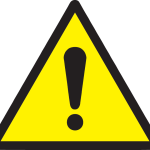
Symbol for general warning:
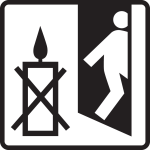
Never leave a burning candle unattended! Always extinguish it before leaving the room, even if just for a “moment”.
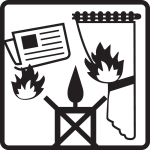
The candle should not be near flammable items!
The candle should not be placed too close to flammable objects.
Remember that the flame can increase in size during burning.
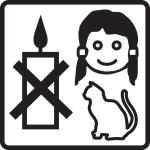
Burning candles should not be near children and pets!
Children and pets may be drawn to burning candles and may accidentally knock them over.
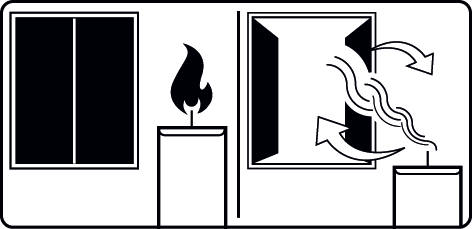
After use, ventilate the room.
Candles consume oxygen and generate moisture. After using candles, you can ventilate the room to freshen the air. Before doing so, extinguish the candles to prevent drafts.

Do not inhale smoke!
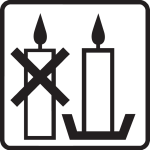
The use of a fireproof base is recommended. This may be relevant for candles in containers and filled jars to prevent damage to the underlying surface.
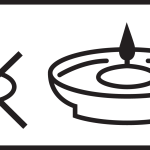
Use in a suitable container with water. This is relevant for candles designed to float on water. These should not be used on rivers, ponds, or lakes.

Candles must be at least x cm apart.
(Where x represents the minimum safety distance between candles)
If candles are too close to each other, heat can cause dripping or even flare-ups.
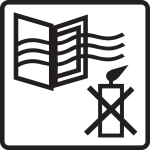
Do not use in a draft!
Strong air movement can affect the flame, causing soot or dripping.
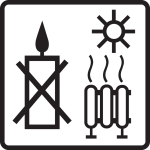
Do not place near a heat source!
A heat source, such as a radiator, fireplace, or strong sunlight, can deform candles.
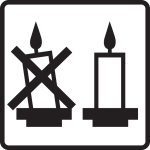
The candle must stand upright.
Tilted candles can tip over or start dripping.

Trim the wick to x cm (where x represents the maximum length of the wick)
… when the candle is not burning. If the wick becomes too long, the flame may become too high and start flickering or producing soot.
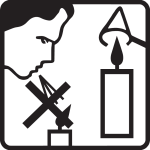
Extinguish the flame, but without blowing.
… or extinguish the flame by dipping the wick into the liquid wax using a metal tweezer, metal spoon handle, and similar tools. There is no risk of flare-ups during this process, and the wick will not emit smoke. Remember to straighten the wick immediately after extinguishing the candle.
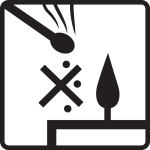
The melted wax must not contain matchstick residues.
The pieces can ignite another flame and cause the candle to drip or burn with a much larger flame.

Do not move a lit candle!
A moving flame or spilled hot wax can cause burns.
Extinguish the candle and let it cool before moving it.
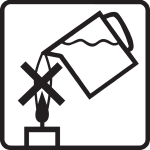
Do not use water or other liquids to extinguish a candle.
Water can explosively evaporate and splatter hot wax, or even ignite it. The correct method is to smother the flame.
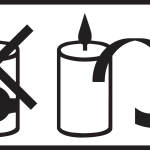
Remove the packaging before use, as it may ignite.

If the rim is wider than x cm (where x represents the maximum height of the rim).
Otherwise, the flame may not receive enough oxygen and may start flickering or producing soot.
It’s easiest if the wax is solid but still warm and soft.
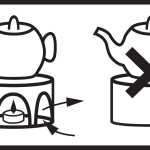
Use only in holders and warmers with proper ventilation.
Inadequate ventilation can lead to excessive heat buildup.
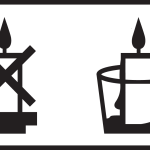
This candle becomes liquid, so use a suitable container.
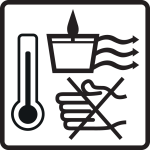
Do not touch the candle, as it may be hot!
Some containers can become hot. Do not touch the burning candle, and after extinguishing it, it must cool down first.
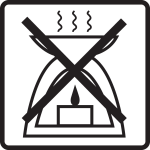
Do not burn in a wax warmer!
Candles are not suitable for burning in a wax warmer, as they can become quite hot and damage the wax warmer.



